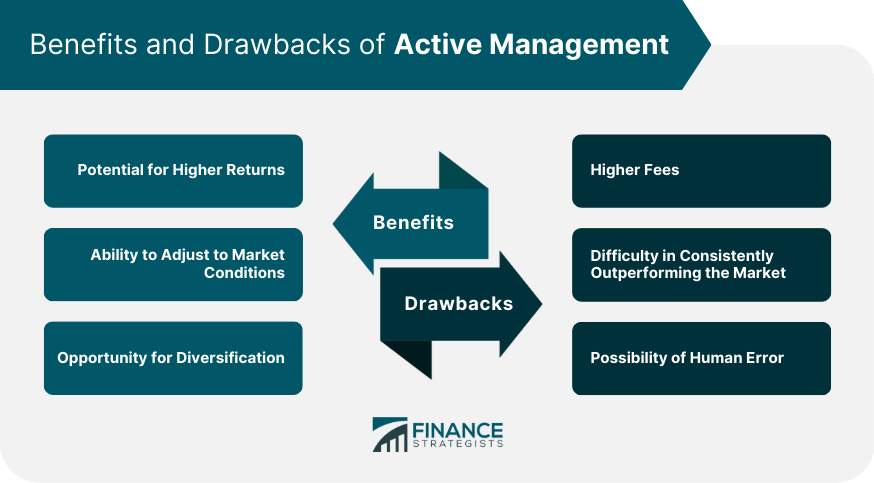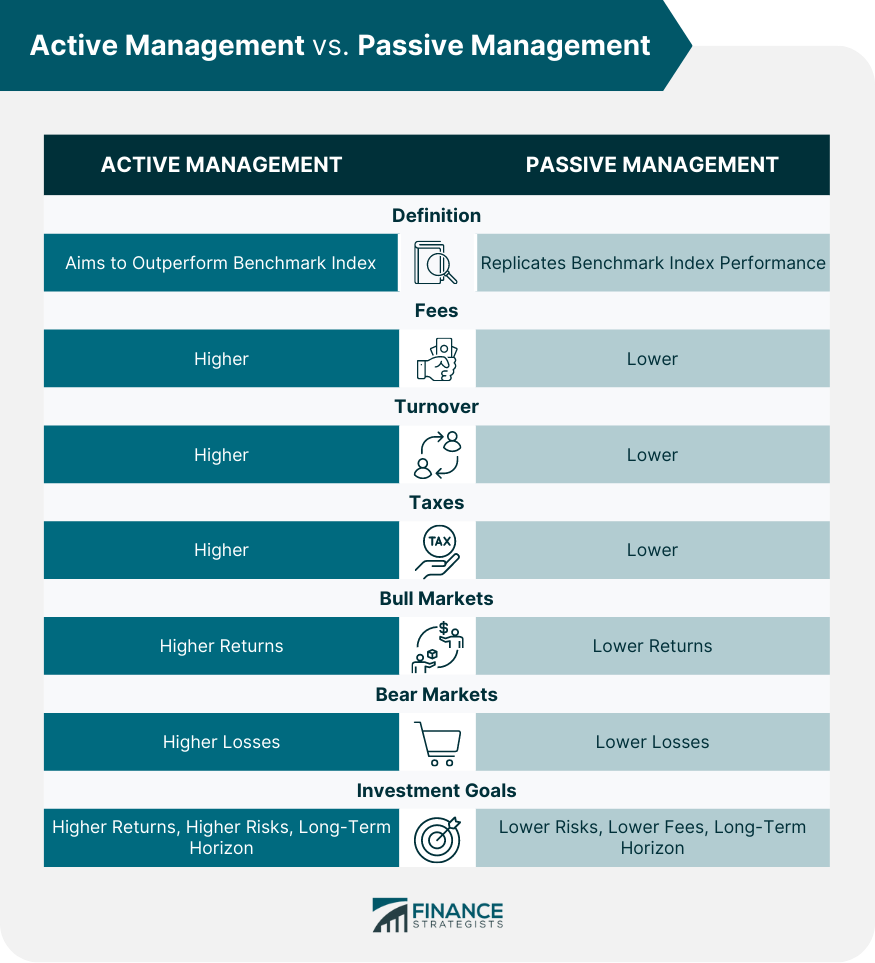What Is Active Management?
Active management is a strategy used by fund managers to make investment decisions based on market trends, fundamental analysis, technical analysis, and quantitative analysis to beat the market's performance.
The goal of active management is to outperform the benchmark index, such as the S&P 500, by investing in stocks that are undervalued or have higher potential for growth.
In contrast, passive management aims to replicate the performance of the benchmark index by investing in the same stocks and in the same proportion as the index.
The purpose of this article is to examine the benefits and drawbacks of active management, explore various active management strategies, compare active and passive management, and provide factors to consider when selecting an active manager.
Benefits of Active Management
Potential for Higher Returns
The primary advantage of active management is the potential for higher returns. Active managers aim to identify undervalued stocks and invest in them, which can lead to higher returns than the benchmark index.
In addition, active managers can also avoid investing in overvalued stocks, which can reduce the risk of underperforming the index.
For instance, active managers may invest in companies with strong fundamentals, such as revenue growth, earnings, cash flow, and dividends, which can lead to higher returns over the long-term.
Ability to Adjust to Market Conditions
Another advantage of active management is the ability to adjust to changing market conditions.
Active managers can quickly respond to changes in the market, such as shifts in economic indicators, political events, or industry-specific news, by adjusting their investment strategies.
For instance, if the Federal Reserve increases interest rates, active managers can reduce their exposure to interest-rate sensitive stocks, such as utilities, and increase their holdings in sectors that benefit from higher rates, such as financials.
Opportunity for Diversification
Active management can also provide an opportunity for diversification by investing in a wide range of sectors, industries, and geographies.
Active managers can identify investment opportunities across various sectors, such as healthcare, technology, consumer staples, and energy, to reduce the risk of underperformance caused by sector-specific risks.
Moreover, active managers can invest in companies with different market capitalizations, such as small, mid, and large-cap stocks, to enhance portfolio diversification.
Drawbacks of Active Management
Higher Fees
One of the main drawbacks of active management is the higher fees charged by fund managers. Active managers typically charge higher fees than passive managers to cover the costs of research, analysis, and trading.
These fees can eat into the returns generated by the fund and reduce the net returns for investors. Moreover, active managers may charge performance-based fees, which can further increase the costs of investing.
Difficulty in Consistently Outperforming the Market
Another disadvantage of active management is the difficulty in consistently outperforming the benchmark index. Active managers may face challenges in identifying undervalued stocks, making accurate predictions about market trends, and avoiding overvalued stocks.
Moreover, active managers may be impacted by market volatility, which can lead to underperformance during turbulent times. Studies have shown that a large majority of active managers underperform the benchmark index over the long-term.
Possibility of Human Error
Active management also involves the risk of human error. Active managers may make investment decisions based on emotions, biases, or incorrect information, which can lead to poor performance.
Moreover, active managers may engage in excessive trading, which can increase the costs of investing and reduce returns. In addition, active managers may be impacted by turnover risk, which can arise from frequent changes in the fund's portfolio.

Active Management Strategies
Fundamental Analysis
Fundamental analysis is a strategy used by active managers to evaluate a company's financial health, competitive position, and growth potential.
Fundamental analysis involves analyzing financial statements, such as balance sheets, income statements, and cash flow statements, to assess a company's revenue, earnings, assets, liabilities, and cash flow.
Moreover, fundamental analysis involves evaluating a company's competitive advantages, such as brand recognition, patents, and intellectual property, to assess its long-term growth potential.
Active managers who use fundamental analysis typically seek companies with strong financials, competitive advantages, and growth potential.
Technical Analysis
Technical analysis is a strategy used by active managers to identify patterns and trends in stock prices and volume to predict future price movements.
Technical analysis involves using charts, graphs, and technical indicators, such as moving averages, support and resistance levels, and relative strength index (RSI), to assess market trends and identify buying and selling opportunities.
Active managers who use technical analysis typically seek to identify patterns and trends in stock prices and volume to make investment decisions.
Quantitative Analysis
Quantitative analysis is a strategy used by active managers to analyze large sets of data and identify patterns and relationships that can be used to make investment decisions.
Quantitative analysis involves using statistical models, machine learning algorithms, and data visualization tools to identify trends, correlations, and anomalies in market data.
Active managers who use quantitative analysis typically seek to identify patterns and relationships in market data to make investment decisions.
Active Management vs. Passive Management
Definition of Passive Management
Passive management is a strategy used by fund managers to replicate the performance of a benchmark index, such as the S&P 500, by investing in the same stocks and in the same proportion as the index.
Passive management involves lower fees than active management since fund managers do not need to conduct research or analysis to make investment decisions.
Moreover, passive management involves lower turnover and lower taxes since fund managers do not need to buy and sell stocks frequently.
Comparison of Performance
Active management and passive management have different performance characteristics. Active management aims to outperform the benchmark index by investing in undervalued stocks and avoiding overvalued stocks.
However, studies have shown that a large majority of active managers underperform the benchmark index over the long-term.
In contrast, passive management aims to replicate the benchmark index's performance by investing in the same stocks and in the same proportion as the index.
Passive management typically generates lower returns than active management during bull markets, but it also generates lower losses during bear markets.
Factors to Consider When Choosing Between Active and Passive Management
When choosing between active and passive management, investors should consider several factors, such as their investment objectives, risk tolerance, time horizon, and fees.
Active management may be suitable for investors who seek higher returns, are willing to accept higher risks, and have a long-term investment horizon. However, active management involves higher fees and the risk of underperformance.
Passive management may be suitable for investors who seek lower fees, lower risks, and a long-term investment horizon. However, passive management may generate lower returns during bull markets.

Factors to Consider When Selecting an Active Manager
Investment Philosophy
Investment philosophy refers to the set of principles and beliefs that guide a fund manager's investment decisions. Investors should consider the fund manager's investment philosophy when selecting an active manager.
For instance, investors who seek value stocks may choose a fund manager who follows a value investing philosophy, such as Warren Buffett.
Similarly, investors who seek growth stocks may choose a fund manager who follows a growth investing philosophy, such as Peter Lynch.
Performance Track Record
Performance track record refers to the fund manager's historical performance relative to the benchmark index and other active managers. Investors should consider the fund manager's performance track record when selecting an active manager.
For instance, investors may review the fund's historical returns, risk-adjusted returns, and alpha, which measures the fund's performance relative to the benchmark index.
Moreover, investors may compare the fund's performance with other active managers who follow a similar investment philosophy and have a similar investment style.
Investment Process
Investment process refers to the set of procedures and protocols that a fund manager uses to make investment decisions. Investors should consider the fund manager's investment process when selecting an active manager.
For instance, investors may review the fund manager's research process, stock selection process, risk management process, and portfolio construction process.
Moreover, investors may evaluate the fund manager's decision-making process, such as whether the fund manager uses a team-based approach or relies on individual expertise.
Conclusion
Active management is a strategy used by fund managers to make investment decisions based on market trends, fundamental analysis, technical analysis, and quantitative analysis to outperform the benchmark index.
Active management has benefits, such as the potential for higher returns, the ability to adjust to market conditions, and the opportunity for diversification.
However, active management also has drawbacks, such as higher fees, difficulty in consistently outperforming the market, and the risk of human error.
Active management involves various strategies, such as fundamental analysis, technical analysis, and quantitative analysis, each with its own strengths and weaknesses.
Moreover, investors should consider various factors, such as investment philosophy, performance track record, and investment process, when selecting an active manager.
In conclusion, active management can be a viable strategy for investors who seek higher returns and are willing to accept higher risks but should be approached with caution and a thorough understanding of its benefits and drawbacks.
Active Management FAQs
Active management is a strategy used by fund managers to make investment decisions based on market trends, fundamental analysis, technical analysis, and quantitative analysis to outperform the benchmark index.
The benefits of active management include the potential for higher returns, the ability to adjust to market conditions, and the opportunity for diversification.
The drawbacks of active management include higher fees, difficulty in consistently outperforming the market, and the risk of human error.
Active management strategies include fundamental analysis, technical analysis, and quantitative analysis, each with its own strengths and weaknesses.
Active management involves fund managers making investment decisions with the aim of outperforming the benchmark index, while passive management involves replicating the performance of the benchmark index by investing in the same stocks and in the same proportion as the index.
True Tamplin is a published author, public speaker, CEO of UpDigital, and founder of Finance Strategists.
True is a Certified Educator in Personal Finance (CEPF®), author of The Handy Financial Ratios Guide, a member of the Society for Advancing Business Editing and Writing, contributes to his financial education site, Finance Strategists, and has spoken to various financial communities such as the CFA Institute, as well as university students like his Alma mater, Biola University, where he received a bachelor of science in business and data analytics.
To learn more about True, visit his personal website or view his author profiles on Amazon, Nasdaq and Forbes.











